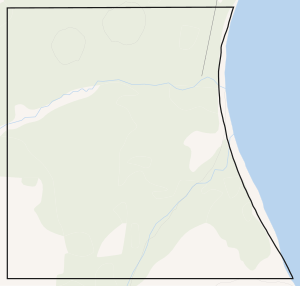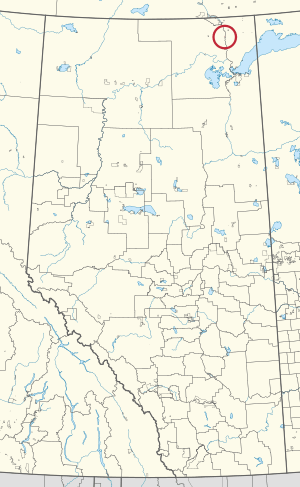Ɂejëre Kʼelnı Kuę́ 196I facts for kids
Quick facts for kids
Ɂejëre Kʼelnı Kuę́ 196I
Hay Camp
|
|
|---|---|
| Ɂejëre Kʼelnı Kuę́ Indian Reserve No. 196I | |

Boundaries of Ɂejëre Kʼelnı Kuę́ 196I
|
|

Location in Alberta
|
|
| First Nation | Smith's Landing |
| Treaty | 8 |
| Country | Canada |
| Province | Alberta |
| Specialized municipality | Wood Buffalo |
| Area | |
| • Total | 213.0 ha (526.3 acre) |
Ɂejëre Kʼelnı Kuę́ 196I, also called Hay Camp, is a special piece of land in northern Alberta, Canada. It is known as an Indian reserve, which means it is land set aside for a First Nations community.
This reserve is one of ten areas managed by the Smith's Landing First Nation. In their own language, they are called the Dene Ch'anie. The land is located on the west side of the Slave River and is inside Wood Buffalo National Park. It covers about 213 hectares (526 acres) of land.
Ɂejëre Kʼelnı Kuę́ 196I is about 113 kilometers (70 miles) north of Fort Chipewyan. It is also about 62 kilometers (39 miles) south of Fort Smith, Northwest Territories. A road called Hay Camp Road connects the reserve to Fort Smith and Fitzgerald.
Contents
What's in a Name?
The name ʔejëre K’elnı Kuę́ comes from the Dënesųłiné language. This is the language spoken by the Smith's Landing First Nation. The special character 'ʔ' is a glottal stop. It's a sound made by briefly closing your throat.
Because this character is not on most keyboards, you might see the name spelled differently. Some common spellings include Ejere K'elni Kue, ?Ejere K'elni Kue, ɂejere K'elni Kųe, and Pejere Kʼelnı Kue.
The name "Hay Camp" started appearing around the early 1900s. This area was known for its hay meadows. It was a common stopping place along the Peace and Slave Rivers. Early writings mention "Russell's Hay Camp," likely run by a Métis riverman named Jack Russell.
A Look Back at History
Before airplanes, the Slave River was the main way to travel through this region. Hay Camp was an important stop between Fort Chipewyan and Fort Smith.
Hay Camp and Wood Buffalo National Park
Wood Buffalo National Park was created in 1922. Hay Camp was chosen as the home for the Chief Park Warden. Since the park's main boss worked from far away in Ottawa, Hay Camp became the park's unofficial main office.
By 1923, people were cutting hay around Hay Camp. This hay was used to feed the park wardens' horses in winter. By 1925, a house, a stable, and a storage building were built there.
In 1952, a decision was made to build a permanent place in Hay Camp to process buffalo meat. This meat was then sold. By this time, most of the park's office work had moved to Fort Smith.
Changes Over Time
When the meat processing plant closed in 1967, Hay Camp became less important. In the 1970s and 1980s, the site was used as a base for fighting forest fires. However, this fire base closed in 1992. It moved to Pine Lake, another area in the park.
In 1994, officials decided to remove all buildings and trash from Hay Camp. The goal was to return the area to its natural state. By 1995, Hay Camp was completely empty. The last buildings, a cabin and a fire tower, were removed in 1999.
Today, all that remains is the spirit of the place and the memories of those who lived and worked there.
A New Beginning
On May 6, 2000, the Smith's Landing First Nation (SLFN) was officially formed. The band was allowed to choose certain lands to become their reserve sites. Hay Camp was one of the places they chose.
Because of this, the site officially became known as ʔejëre K’elnı Kuę́. It was no longer under the park's control. Many people from the SLFN had worked at Hay Camp for the park over the years. Now, the SLFN and Parks Canada plan to work together. They want to share the history of this important place.

